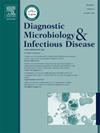Off-label use of the BIOFIRE® Blood Culture Identification 2 Panel for multidrug-resistant bacteria colonization surveillance in critical care unit patients: A retrospective study
IF 2.1
4区 医学
Q3 INFECTIOUS DISEASES
Diagnostic microbiology and infectious disease
Pub Date : 2025-05-27
DOI:10.1016/j.diagmicrobio.2025.116930
引用次数: 0
Abstract
In this retrospective, single-center, observational study we assessed the performance of the BIOFIRE® Blood Culture Identification 2 (BCID2) Panel for the identification of multidrug-resistant bacteria (MDRB)-colonized critical care unit patients compared with a standard culture and antimicrobial susceptibility testing (AST)-based approach. A total of 146 rectal/pharyngeal/nasal combined specimens from 130 patients were tested by using the BCID2 panel. MDRB were detected in 40/146 (27.3%) specimens from 39 patients (30%) by the BCID2 panel; MDRB were recovered by culture in 32/146 (21.9%) specimens from 30 patients (23%). Concordance between the MDRB detected by the BCID2 panel and those recovered by culture was observed in 29/43 cases; MDRB were more frequently extended-spectrum beta-lactamase-harboring Enterobacterales or vanA/B-carrying Enterococcus faecium. The per specimen positive and negative percentage agreement values were 90.6% and 90.3%, respectively (Kappa value: 0.73). The BCID2 panel shows promise as a tool for the rapid identification of MDRB carriers in critical care units. Its use may lead to prescription of more refined empirical antimicrobial therapies on an individual basis and allow timely isolation of patients to prevent MDRB spreading. Nevertheless, larger, multicenter, prospective, and Next-generation sequencing-validated studies are needed to corroborate our findings.
BIOFIRE®血培养鉴定面板在重症监护病房患者中用于多药耐药菌定殖监测的适应症外使用:一项回顾性研究
在这项回顾性、单中心、观察性研究中,我们评估了BIOFIRE®血液培养鉴定2 (bbcid2)小组在鉴定多药耐药细菌(MDRB)定植的重症监护病房患者中的性能,并与基于标准培养和抗生素敏感性试验(AST)的方法进行了比较。使用bccid2面板对来自130例患者的146份直肠/咽/鼻联合标本进行检测。39例(30%)患者的bccid2检测到40/146例(27.3%)MDRB;30例患者(23%)146份标本中有32份(21.9%)培养出MDRB。在29/43的病例中,bccid2小组检测到的MDRB与培养恢复的MDRB一致;MDRB多为携带广谱β -内酰胺酶的肠杆菌或携带vanA/ b的屎肠球菌。每个标本阳性和阴性百分比一致性值分别为90.6%和90.3% (Kappa值为0.73)。bccid2面板有望成为快速识别重症监护病房中MDRB携带者的工具。它的使用可能导致在个体基础上开出更精细的经验性抗菌治疗处方,并允许及时隔离患者以防止耐多药耐药性的传播。然而,需要更大规模、多中心、前瞻性和下一代测序验证的研究来证实我们的发现。
本文章由计算机程序翻译,如有差异,请以英文原文为准。
求助全文
约1分钟内获得全文
求助全文
来源期刊
CiteScore
5.30
自引率
3.40%
发文量
149
审稿时长
56 days
期刊介绍:
Diagnostic Microbiology and Infectious Disease keeps you informed of the latest developments in clinical microbiology and the diagnosis and treatment of infectious diseases. Packed with rigorously peer-reviewed articles and studies in bacteriology, immunology, immunoserology, infectious diseases, mycology, parasitology, and virology, the journal examines new procedures, unusual cases, controversial issues, and important new literature. Diagnostic Microbiology and Infectious Disease distinguished independent editorial board, consisting of experts from many medical specialties, ensures you extensive and authoritative coverage.

 求助内容:
求助内容: 应助结果提醒方式:
应助结果提醒方式:


